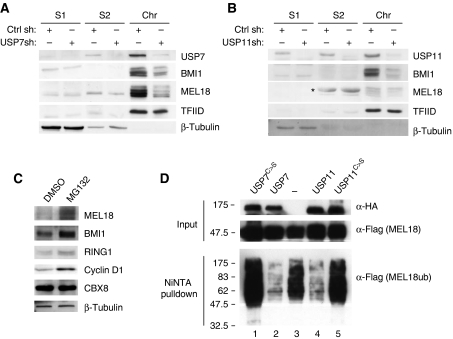Figure 7.
USP7 and USP11 affect the ubiquitination status of MEL18 and BMI1. (A, B) Cellular fractionation was performed as in Figure 3 using FDF cells transduced with control shRNA (Ctrl) and either USP7shRNA (A) or USP11 shRNA (B) as indicated. Ablation of USP7 or USP11 significantly reduced the amount of chromatin-associated BMI1 and MEL18, but had little effect on the distribution of TFIID or β-tubulin. ‘*' Indicates a non-specific band. (C) FDFs were treated with MG132 or the solvent control (DMSO) for 4 h and the levels of the indicated proteins were analysed by immunoblotting. (D) 293T cells that stably express MEL18-Flag were transfected with plasmids encoding His6-ubiquitin alone or in combination with HA-USP7WT, HA-USP7C223S, HA-USP11WT or HA-USP11C275S. Ubiquitinated proteins were recovered on NiNTA beads under denaturing conditions and analysed by SDS–PAGE and immunoblotting. In the absence of USPs, MEL18 is clearly ubiquitinated (lane 3), whereas co-expression of wild-type USP7 or USP11 removes the ubiquitin marks (lanes 2 and 4). The catalytically inactive USP7 and USP11 mutants (USPC>S) were unable to remove the ubiquitin mark from MEL18.

